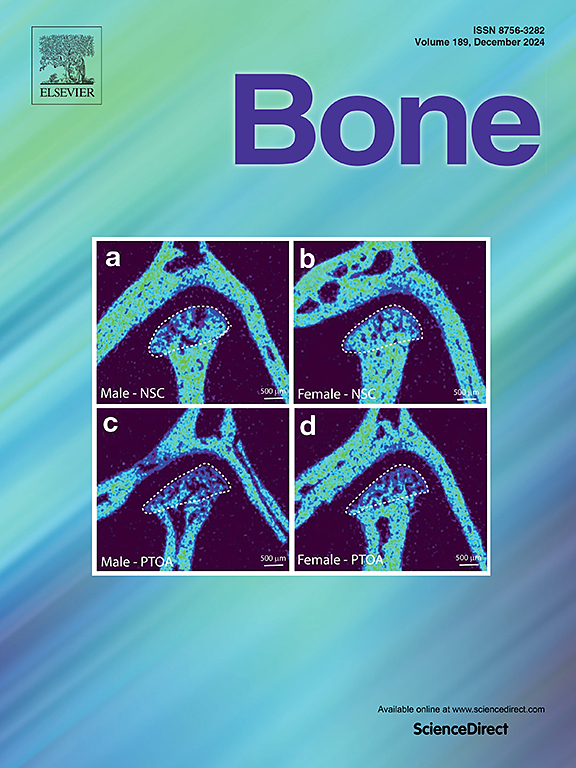Teriparatide administration is osteoanabolic but does not impact atherosclerotic plaque calcification and progression in a mouse model of menopause
IF 3.5
2区 医学
Q2 ENDOCRINOLOGY & METABOLISM
引用次数: 0
Abstract
Menopause exacerbates osteoporosis and increases the risk of atherosclerotic plaque rupture, leading to cardiovascular mortality. Osteoporotic women are increasingly treated with teriparatide (TPTD, 1–34 parathyroid hormone), one of the few treatments that stimulate bone formation. Despite the fact that atherosclerotic plaque calcification is a hallmark of plaque development, the impact of TPTD administration on plaque calcification remain unclear. In this context, we sought to determine the effects of TPTD administration on atherosclerosis in ovariectomized (OVX) apolipoprotein E deficient mice (ApoE−/−), as a model of postmenopausal osteoporosis. OVX ApoE−/− mice, fed a high fat, high cholesterol diet to induce atherosclerosis, received either vehicle or TPTD daily injections (40 μg/kg/d) for 4 or 10 weeks, at which points plaques are respectively weakly and heavily calcified. After sacrifice, bone remodeling was evaluated by serum markers and bone histomorphometry. Bone architectural parameters were measured by μCT. Aortic plaques were analyzed histologically, and their calcification with von Kossa staining and the calcium tracer Osteosense. Plaque inflammation and calcification markers were measured by RT-qPCR. Intermittent TPTD increased bone volume in OVX mice, due to a higher stimulation of bone formation relatively to bone resorption. These effects were not accompanied by changes in serum levels of cholesterol, triglycerides, glucose or insulin. TPTD neither significantly affected aortic plaque size, inflammation, and calcification, even if it slightly increased vascular smooth muscle cell transdifferentiation into calcifying cells. In conclusion, TPTD exhibits osteoanabolic effects in OVX ApoE−/− mice, without significantly influencing atherosclerotic plaque progression or calcification in the short term.
注册报告第 II 阶段:在更年期小鼠模型中,服用特立帕肽可促进骨合成,但不会影响动脉粥样硬化斑块的钙化和进展。
绝经会加剧骨质疏松症,增加动脉粥样硬化斑块破裂的风险,导致心血管疾病死亡。骨质疏松症妇女越来越多地接受特立帕肽(TPTD,1-34 甲状旁腺激素)治疗,这是少数几种刺激骨形成的治疗方法之一。尽管动脉粥样硬化斑块钙化是斑块发展的标志,但服用特立帕肽对斑块钙化的影响仍不清楚。在这种情况下,我们试图确定服用 TPTD 对卵巢切除(OVX)载脂蛋白 E 缺乏小鼠(ApoE-/-)动脉粥样硬化的影响,以此作为绝经后骨质疏松症的模型。卵巢切除载脂蛋白 E 缺失小鼠(ApoE-/-)以高脂肪、高胆固醇饮食诱发动脉粥样硬化,每天注射载脂蛋白 E 或 TPTD(40 μg/kg/d),持续 4 或 10 周,此时斑块分别出现弱钙化和重钙化。牺牲后,通过血清标记物和骨组织形态测量法评估骨重塑情况。骨结构参数通过μCT测量。对主动脉斑块进行了组织学分析,并用von Kossa染色法和钙示踪剂Osteosense分析了斑块的钙化情况。斑块炎症和钙化标记物通过 RT-qPCR 进行测量。间歇性 TPTD 增加了 OVX 小鼠的骨量,这是因为相对于骨吸收而言,TPTD 对骨形成的刺激更大。这些影响并不伴随血清中胆固醇、甘油三酯、葡萄糖或胰岛素水平的变化。TPTD 对主动脉斑块大小、炎症和钙化均无明显影响,即使它能轻微增加血管平滑肌细胞向钙化细胞的转分化。总之,TPTD对OVX载脂蛋白E-/-小鼠具有骨合成代谢作用,但不会在短期内明显影响动脉粥样硬化斑块的进展或钙化。
本文章由计算机程序翻译,如有差异,请以英文原文为准。
求助全文
约1分钟内获得全文
求助全文
来源期刊

Bone
医学-内分泌学与代谢
CiteScore
8.90
自引率
4.90%
发文量
264
审稿时长
30 days
期刊介绍:
BONE is an interdisciplinary forum for the rapid publication of original articles and reviews on basic, translational, and clinical aspects of bone and mineral metabolism. The Journal also encourages submissions related to interactions of bone with other organ systems, including cartilage, endocrine, muscle, fat, neural, vascular, gastrointestinal, hematopoietic, and immune systems. Particular attention is placed on the application of experimental studies to clinical practice.
 求助内容:
求助内容: 应助结果提醒方式:
应助结果提醒方式:


